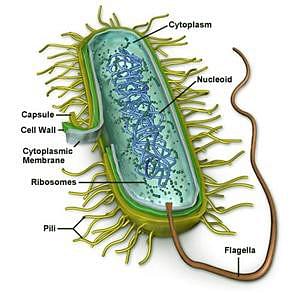In which kingdom would you classify the archaea and nitrogen-fixing organism, if the five-kingdom system of classification is used:
- Plantae
- Fungi
- Protista
- Monera
The Correct Option is D
Solution and Explanation
In the five-kingdom system of classification, archaea would be classified under the kingdom Monera. Nitrogen-fixing organisms, which can include certain bacteria, are also typically classified in the kingdom Monera due to their prokaryotic nature.
So, the correct option is (D): Monera
Top Questions on Biological Classification
Each of the following characteristics represents a Kingdom proposed by Whittaker. Arrange the following in increasing order of complexity of body organization.
A. Multicellular heterotrophs with cell wall made of chitin.
B. Heterotrophs with tissue/organ/organ system level of body organization.
C. Prokaryotes with cell wall made of polysaccharides and amino acids.
D. Eukaryotic autotrophs with tissue/organ level of body organization.
E. Eukaryotes with cellular body organization.
Choose the correct answer from the options given below:- NEET (UG) - 2025
- Biology
- Biological Classification
- Which of the following organisms is correctly matched with its kingdom?
- CUET (UG) - 2025
- Biology
- Biological Classification
- The difference in characters within very closely related groups of organisms are called:
- TS POLYCET - 2025
- Biology
- Biological Classification
- Which kingdom is included in all kingdom system classifications?
- AIIMS BSc Nursing - 2024
- Biology
- Biological Classification
- Match List I with List II
List I List II A Typhoid I Fungus B Leishmaniasis II Nematode C Ringworm III Protozoa D Filariasis IV Bacteria
Choose the correct answer from the options given below:- NEET (UG) - 2024
- Biology
- Biological Classification
Questions Asked in NEET exam
- Two identical point masses P and Q, suspended from two separate massless springs of spring constants \(k_1\) and \(k_2\), respectively, oscillate vertically. If their maximum velocities are the same, the ratio of the amplitude of P to the amplitude of Q is :
- NEET (UG) - 2025
- Waves and Oscillations
A sphere of radius R is cut from a larger solid sphere of radius 2R as shown in the figure. The ratio of the moment of inertia of the smaller sphere to that of the rest part of the sphere about the Y-axis is :

- NEET (UG) - 2025
- Moment Of Inertia
- A microscope has an objective of focal length \(f_o = 2\) cm and an eyepiece of focal length \(f_e = 4\) cm. The tube length of the microscope is \(L = 40\) cm. If the distance of distinct vision of eye is \(D = 25\) cm, the magnification in the microscope is:
- NEET (UG) - 2025
- Optical Instruments
AB is a part of an electrical circuit (see figure). The potential difference \(V_A - V_B\), at the instant when current \(i = 2\) A and is increasing at a rate of 1 amp/second is:

- NEET (UG) - 2025
- Electromagnetic Induction and Inductance
- Twins are born to a family that lives next door to you. The twins are a boy and a girl. Which of the following must be true?
- NEET (UG) - 2025
- Genetics
Concepts Used:
Kingdom Monera
Characteristics of Monera Kingdom
The organisms in this kingdom have the following characteristics: -
- Monerans are single-celled creatures.
- The cell wall is made up of peptidoglycan and is stiff.
- Binary fission is asexual reproduction.
- They have 70S ribosomes in them.
- The locomotory organ is the flagella.
- Organelles such as mitochondria, lys
- osomes, plastids, Golgi bodies, endoplasmic reticulum, centrosome, and others are not present.
- These are decomposers and mineralizers for the environment
